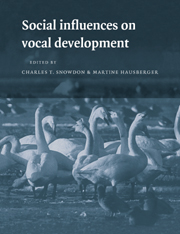Book contents
- Frontmatter
- Contents
- List of contributor
- 1 Introduction
- 2 Social interaction and sensitive phases for song learning: A critical review
- 3 Social interaction and vocal development in birds
- 4 Building a social agenda for the study of bird song
- 5 Field observations, experimental design, and the time and place of learning bird songs
- 6 Vocal learning in wild and domesticated zebra finches: Signature cues for kin recognition or epiphenomena?
- 7 What birds with complex social relationships can tell us about vocal learning: Vocal sharing in avian groups
- 8 Social influences on song acquisition and sharing in the European starling (Sturnus vulgaris)
- 9 Social influences on the acquisition of human-based codes in parrots and nonhuman primates
- 10 Vocal learning in captive bottlenose dolphins: A comparison with humans and nonhuman animals
- 11 Vocal learning in cetaceans
- 12 Social influences on vocal development in New World primates
- 13 Some general features of vocal development in nonhuman primates
- 14 Social influences on vocal learning in human and nonhuman primates
- 15 The resilience of language in humans
- 16 Reciprocal interactions and the development of communication and language between parents and children
- 17 Crafting activities: Building social organization through language in girls' and boys' groups
- Index
8 - Social influences on song acquisition and sharing in the European starling (Sturnus vulgaris)
Published online by Cambridge University Press: 04 August 2010
- Frontmatter
- Contents
- List of contributor
- 1 Introduction
- 2 Social interaction and sensitive phases for song learning: A critical review
- 3 Social interaction and vocal development in birds
- 4 Building a social agenda for the study of bird song
- 5 Field observations, experimental design, and the time and place of learning bird songs
- 6 Vocal learning in wild and domesticated zebra finches: Signature cues for kin recognition or epiphenomena?
- 7 What birds with complex social relationships can tell us about vocal learning: Vocal sharing in avian groups
- 8 Social influences on song acquisition and sharing in the European starling (Sturnus vulgaris)
- 9 Social influences on the acquisition of human-based codes in parrots and nonhuman primates
- 10 Vocal learning in captive bottlenose dolphins: A comparison with humans and nonhuman animals
- 11 Vocal learning in cetaceans
- 12 Social influences on vocal development in New World primates
- 13 Some general features of vocal development in nonhuman primates
- 14 Social influences on vocal learning in human and nonhuman primates
- 15 The resilience of language in humans
- 16 Reciprocal interactions and the development of communication and language between parents and children
- 17 Crafting activities: Building social organization through language in girls' and boys' groups
- Index
Summary
INTRODUCTION
Vocal learning is a very widespread characteristic of songbirds, and a large variety of these learning processes has been described over the last decades. Learning can lead to different types of variation and results in song sharing that can be geographically localized and is then considered as “dialects.” The distribution of these variations can be limited to a few birds and/or cover large areas. Experimental studies have given precise information about the mechanisms involved, in particular in terms of “timing.” However, naturalistic validations may be necessary for us to fully understand the functional significance of vocal learning (see discussion of the sensitive periods, in the literature). There is a need for integrative studies and it is important to consider communication in its own context, which is that of social interaction (for language as a social act, see Goodwin 1990). A social organization needs an adapted communicative system, and comparative studies can give us hints about the evolutionary bases of vocal learning. Comparison can be made between species or phylogenetic groups but also between populations of a same species.
Likely candidates to help us to understand these processes are highly social animals that can adapt to different social environments. Starlings clearly correspond to this definition and here I examine through experimental and naturalistic studies the possible relation between song acquisition, song sharing and social organization.
The European starling (Sturnus vulgaris) occupies the largest geographic range of all the species of Sturnus (Feare 1984). It is present in Asia and in Europe from Scandinavia to Spain and Italy, and even in North Africa. It has also been introduced successfully in North America, New Zealand, and South Africa.
- Type
- Chapter
- Information
- Social Influences on Vocal Development , pp. 128 - 156Publisher: Cambridge University PressPrint publication year: 1997
- 25
- Cited by

